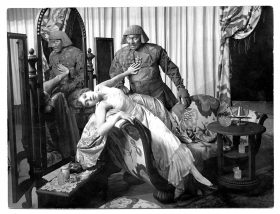 “Jewrovision”, the largest singing and dancing competition for Jewish youth in Europe, will take place this year for the 16th time. Last year an audience of over 2,000 gathered at the Rose Garden Hall in Mannheim, accompanying the brilliant stage show produced by youth centers with frenetic applause. It’s hard to imagine that Jewrovision 2002 was just one of a number of evening programs at a Jewish recreational camp called Machané. Back then, at a recreational center in Bad Sobernheim (not far from Frankfurt), six groups from various cities appeared on a stage just three yards wide. Today, only 15 years later, there are 18 teams presenting their multi-media performances on enormous stages in much larger venues. An extraordinary development. → continue reading
“Jewrovision”, the largest singing and dancing competition for Jewish youth in Europe, will take place this year for the 16th time. Last year an audience of over 2,000 gathered at the Rose Garden Hall in Mannheim, accompanying the brilliant stage show produced by youth centers with frenetic applause. It’s hard to imagine that Jewrovision 2002 was just one of a number of evening programs at a Jewish recreational camp called Machané. Back then, at a recreational center in Bad Sobernheim (not far from Frankfurt), six groups from various cities appeared on a stage just three yards wide. Today, only 15 years later, there are 18 teams presenting their multi-media performances on enormous stages in much larger venues. An extraordinary development. → continue reading
“This four-minute performance means three to four months of training”
Horror and Magic in the Silent Golem Movies

In the light comedy The Golem and the Dancing Girl from 1917, Paul Wegener satirizes his own 1915 film The Golem; photo: Deutsches Filminstitut, Frankfurt a. M./estate Paul Wegener – collection Kai Möller
In January of 1915 the figure of a golem appeared for the first time on the silver screen, on Berlin’s Kurfürstendamm. The public was captivated by a truly modern monster. At the same time, southeast of the Belgian city of Ypres battles of the First World War were raging. Following on the heels of this first silent golem movie came two more in 1917 and 1920, also debuting in Berlin. The lead role of the golem was played in all of them by Paul Wegener, who had also come up with the idea for the projects and written the screenplays.
In the current exhibition GOLEM (more on www.jmberlin.de/en/golem), a theme room has been dedicated to these three silent movies. → continue reading
A Golem is Going Around Berlin
The golem, a character from Jewish mythology, is currently present in an interesting exhibition at the Jewish Museum Berlin. But not only there.

Yves Gellie, Human Version 2.08, Dancing Robot, Tohoku University, Japan; photo: Yves Gellie, galerie du jour agnès b
Guest article by Roberto Giardina, www.ildeutschitalia.com
In the foyer of the Museum for Communication, three robots – reminiscent of chess figures – are roaming around. They talk to the people walking up to them, stop and take a different route if you block their way, or accompany you when you walk next to them. Adults are just as fascinated as children. A visit to Berlin museums is fun, and doesn’t necessarily require you to speak German.
After playing on the ground floor at the Museum for Communication, you can visit the special exhibition on the Golden Section and have your forgotten school knowledge entertainingly refreshed (the exhibition Göttlich Golden Genial (godly golden genius) runs until 26 February, more on the Museum for Communication website (in German)).
Robots are fun to play with, but they have been the stuff of nightmares since time immemorial – will they take our jobs away from us soon? → continue reading